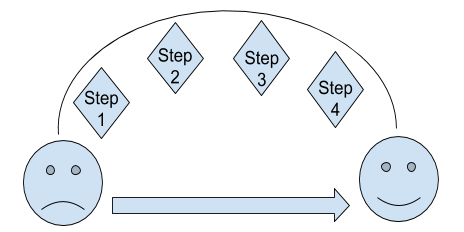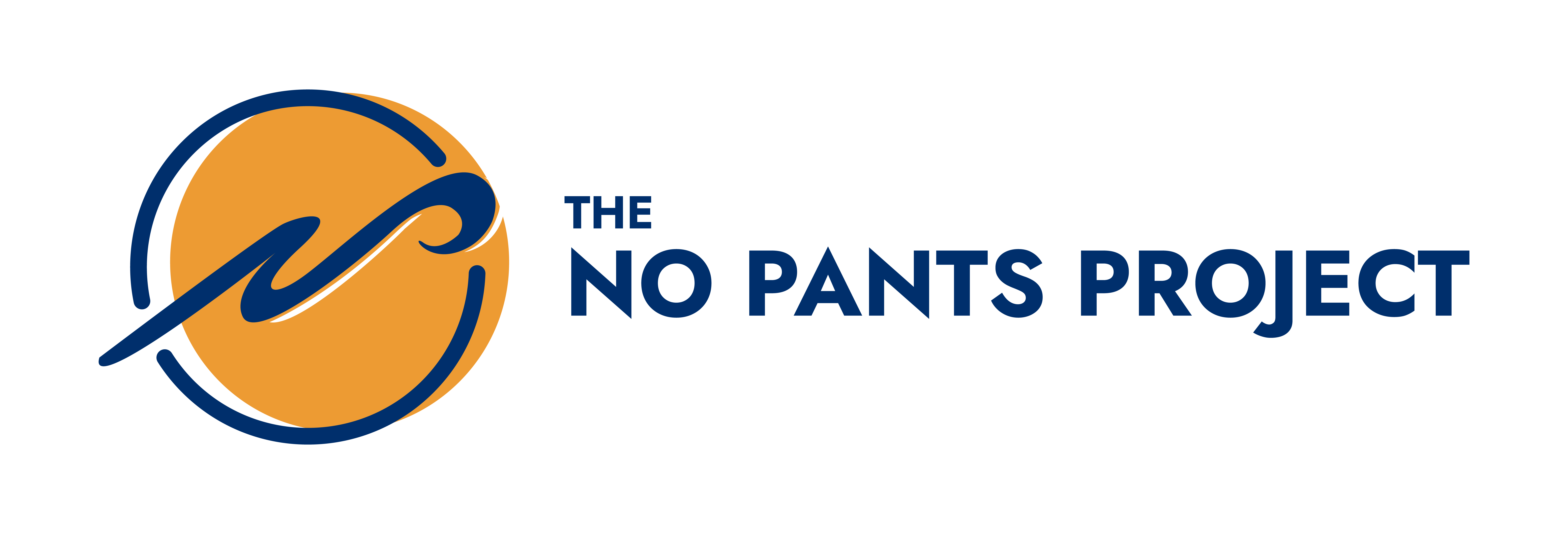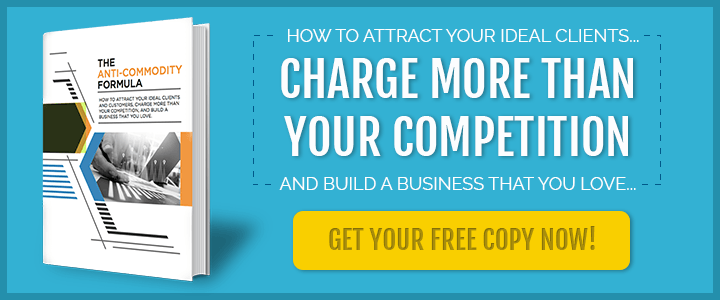Proposals. They’re an interesting concept, aren’t they?
You write up a document that asks someone to do business with you, and then you sit and wait for them to respond (hopefully in the positive).

Not all clients require proposals, but in certain cases (like large projects, or if the client needs to get approval from a higher up before they can say yes) you may find yourself needing to create one.
You want your document to be engaging, convince your prospect of your value, and, above all else, to be crystal clear about what expectations both parties should have.
Before you just start filling out a template, it’s important to put careful thought into exactly what your potential client needs, and how you can best demonstrate your ability to help them when you write your proposal.
By using these steps you can make sure you sound professional, that you’ve thought through all scenarios, and that you’ve got your bases covered.
1) Research
Having some background information on the person and company you are creating your proposal for may seem like a lengthy step saved for only over achievers.

But if you consider that this step could be the difference between landing a quality client, and having to start your search again from scratch, it is time well invested.
“If you don’t spend the time to think about your audience and gather some intelligence about their needs and challenges, you are less likely to get the outcome you want. Maybe it is a hard no, maybe you have to schedule some follow-up meetings. Either way, you are now going to have to spend time either finding a new direction or refining your argument, which means that you’ll have to do that research you put off in the first place. It’s just ultimately taking up twice as much time for both you and your audience.”
“What’s more, if you haven’t gotten to know your audience, you are that much more likely to make a mistake — like failing to anticipate a major objection — that will cause you embarrassment and cost you credibility. And you’ve wasted your audience’s time too — another blow to your credibility.”
Gathering information, as a rule, is the first step in all writing and before you can help someone, it’s crucial to have a solid understanding of who they are.
You can choose to first do some research online and then, if possible, book a call with the prospect so they may answer any remaining questions you have.
Questions to guide your research might look like this:
- How long has my prospect worked for this company or owned this business?
- What, exactly, does this business do?
- Who are their competitors?
- What makes them remarkable?
- Who are their customers?
- What kind of revenue does this business bring in?
- What are they hoping I will accomplish for them?
- Have they hired for this type of help in the past?
- What was the outcome of that job?
- Am I willing to do more or less than their previous freelancer?
- Will I charge more or less than their previous freelancer?
- Will I work independently, or do they expect to heavily collaborate?
- If they want to be hands off, what kind of information will I need from them before beginning?
Taking the time to do some thorough research, and ask the right questions, will help give you a picture of what exactly you are entering into.
This step will also help guide all of the future conversations with your client.
2) Pain
Now that you know your audience better, you probably think you have a fairly good idea which particular struggles they are faced with.
But whether you can make an educated guess or not, there’s a way you can guarantee that you speak to their specific problems well before you write your proposal.
Ask.
And then listen.
Really listen.

Before you ever attempt to solve the issues you perceive your prospect to have, set up an interview and listen to them talk about their pains in their very own words.
Without this step, you are going in blind and can totally miss the mark.
Erin Myers, of OutboundEngine, says, “Whether you realize it or not, your preconceived notions influence your interaction with clients. For example, if you come in thinking your client’s primary pain is poor time management you may ask questions differently, inadvertently leading the conversation. As a result, you won’t gather new information or insight into where your client could actually use your assistance.”
We all know the old adage about what assuming does.
And you can’t have the solutions, until you know the real problems.
It’s a good idea to focus on open ended questions, so you aren’t unintentionally leading the conversation.
Some questions might be:
- What’s your biggest current challenge?
- What will happen if that challenge doesn’t get resolved?
- How do you think the problem could be best solved?
- What have you done in the past to try to remedy this problem?
Take time to ask the right questions and make sure you have total clarity on where your prospect’s biggest pains are.
When you go into the beginning of your proposal, it’s good to recap the discussion you had with your prospect about their pain points so that they know you were listening and truly understood their problems.
Once you’ve repeated their goals back to your client, you can then share the ways you’re willing to help.
3) Process
When we think of proposals, the process is the meat and bones.
It’s kind of the point, right?
“I have an issue, and I want to know how you’ll fix it.”
One great way to lay out the process for your client is something that Mike Shreeve teaches in The No Pants Project, called the “Client Outcome Journey.”
The “Client Outcome Journey” is a process of breaking down your client’s large goal into small, manageable steps.
The smaller steps serve your client by getting them quick wins that move them closer to their ultimate goal, without overwhelming them too much with the big picture details.
Anna Kaine, of esminbound.com, says this about the value of quick wins, “Requiring low effort and visible results, quick wins build trust while you’re busy establishing the all-important foundations for your customer. Using their goals, provide them with a success story soon after they’ve bought in, and – without sacrificing the long-term work – integrate a quick-win project into the early days of working together. Make sure you share these results with your customer to communicate the progress you’re making.”
The small wins also work to build a relationship of mutual trust between client and freelancer.
The steps should start out as low ticket items, and then gradually move up in cost and value.
An example of this would be a videographer whose superpower is to “help clients help people lose weight with funny videos.”
“This is great,” says the CEO of Lose Weight Inc.
“But how?”
So the videographer creates an outcome journey to show the CEO, with four steps. Each step will move her closer to the company’s ultimate goal.
The steps might look like this:
- Create a content strategy
- Teach script writing to the CEO’s team in an online workshop
- Offer to critique the team’s script
- Create slides for video and manage the team as they put it together

As you lay out the steps that you will take to accomplish your prospect’s goals, keep one thing in mind:
Clients care more about what you can do for them, than the process by which you do it.
Addison Duvall, of hongkiat.com, says, “The closer your solution is to a genuine, major pain point, the more a client will value your work, and the less they will complain about paying you what you’re worth.”
Give your prospect necessary details, but don’t weigh them down with each tedious step of the process. They are mostly interested in the results your process will bring them, and the pain you will be relieving.
4) Outcome
Outcome is the name of the game.
As stated in the last step, while the process has value, the end result is what your prospect is most interested in.
Your client wants to know what they will be guaranteed when they hire you, and this is what the primary point of your proposal should be.
But.
Before you go swearing to make your client’s wildest dreams come true, think hard about the outcome you are offering, and make sure you are capable of getting (at least) the exact results you’re promising, in less time than you’re promising to get them in.
For the sake of your reputation, this is critical and worth thorough consideration.
Rocco Baldassarre, founder of the award winning digital marketing agency Zebra Advertisement, says, “It is better to under promise and over deliver. On average, unhappy customers share their experience with 20 people or more while satisfied customers share their experience with three or four people. One way to avoid the nay-sayers is to set realistic expectations from the get go and take on only clients that are happy with that.”
5) Price
Talking price can be an uncomfortable moment for any freelancer.
Take some time to consider your prices and the value of what you’re offering.
Once you have set your fees, think about some objections your prospect may have. Ask yourself if you’re willing to compromise, or not, and in what ways.
For example, can you offer a template, rather than a done-for-you service, and decrease your price?
Having a few package options ready for your prospect shows a preparedness and a willingness to lend aid, no matter their budget.
Dodie Martz, associate partner of Eleven Inc, advises, “Be open about your fees and what you think it will take to deliver on the relationship. … If the price is too high, remain open to negotiate on some options that give them what they want — at a price you both agree is fair and reasonable.
“You may need to walk away if the negotiations don’t work out, but not until you’ve provided them with some other ways they could get the work done. For example, you might be able to connect them with people you know and trust.”
And above all else, have confidence in your worth.
A good way to discuss price in your proposal is to put it in terms of the goals your client has shared with you.
This will lend a greater perspective to the fee you’re charging and the value you will bring them.
If your prospect is hoping to bring in a specific annual revenue, show them that to accomplish their goal you need a certain fee so you can appropriately commit to helping them.
If you can portray your services as an investment, your prospect will be more likely to see how high your value truly is.
If you are leading with value, and you aren’t trying to manipulate, you should always feel good about the offer you leave on the table.
6) Format
When it comes to professional documents, some freelancers throw the rules of formatting out the window.
But in the case of a proposal, “goldfish formatting” is arguably more important than ever.

The idea behind goldfish formatting, is that people rarely read through web content in its entirety.
The average internet cruiser has about the same nine-second attention span as a goldfish, so the formatting that a content creator uses is key in order to keep up with the reader’s short focus.
Jacob Funnell, of writing-skills.com, explains, “Your document’s presentation may seem like a small point. Yet it could be the difference between your hard work being read and acted on or it being put aside for a ‘later’ that never comes.”
And even if your prospect doesn’t brush you aside, it is critical that they have complete clarity about what they are being guaranteed, in what time frame, and at what price.
The amount of business relationships that fall apart due to miscommunication alone are high, and the only remedy is total candor and transparency.
Help your prospect get this clarity with professional, but simple language.
Use plenty of white space, headers, and bullet points to make your proposal easy to read, and leave no room for guesswork.
7) Conclusion
Your conclusion should be a testament to why you are the freelancer for the job.
While it can be tempting to want to start with this information, it is best saved for the end, because this is actually the very last thing your prospect is interested in.
They first want to know that you understand them, that you can help them, and how you will.
But just the same, your conclusion does have an important place of its own.
This is your opportunity to concisely explain why no one will do this job better than you will.
You know your prospect’s pain points better than anyone, because you have taken the time to really listen.
You have creative solutions for them that will get them small wins from the very beginning, and you will lead them to bigger wins until their pain is solved.
You might have case studies, or social proof, or client testimonials or an impressive portfolio.
This is where you talk about those things and show your prospect how you have helped people (or how these methods have helped people) just like them.
Show your prospect:
- Examples of relevant work that you’ve done
- What you’ve studied or who you have trained under, if applicable
- What your beliefs are, and the methods you will use to help them reach their goals
Writer, entrepreneur, and content marketing consultant Ryan Robinson says, “Whatever the task you’re applying to do for a potential client, it’s your job to tailor your strengths to that particular job. Learning how to highlight your most attractive abilities for the specific needs of an individual client is an invaluable skill.”
Confidently bring your skills to the table and leave your prospect with a well rounded picture of who you are and what you are capable of.
8) Proofread
Last, but not least, check yourself.
Thoroughly proofreading is another step that can seem tedious and unnecessary, but will undoubtedly save you grief in the future.
Comb over your proposal, make sure it looks professional, ensure that the timeline is reasonable, and that your prospect’s pain points are addressed.
Rachel Fairbank, owner of the proofreading agency Red Ribbon Communications, says, “Proofreading provides the final polish to your words, ensuring clarity of message. It can provide peace of mind that your communications are the best they can be, and it frees you up to concentrate on what you do best. Proofreading can help you avoid embarrassment, negative feedback, and the time and cost of correcting errors.
“Think of proofreading as the last line of defence before facing the world. You have showered, brushed your teeth, put together a great outfit and eaten a healthy breakfast; proofreading is the last look in the mirror to ensure you don’t have anything stuck in your teeth or a coffee stain on your shirt.”
Let your document rest for a day, if possible, and return to read it over once more before sending it off.
And then, all that’s left is to relax. It’s tempting to drive yourself crazy while waiting for a prospect’s response, but remember – the clients that you want to work with will see your value without any forceful selling or added stressing.
Your only jobs are to demonstrate your value, and to be a service provider who works with integrity.
Hit send, and keep moving forward.
Proposal Writing Steps:
- Research
Understand who your client is. - Pain
Find and acknowledge their biggest problem. - Process
Lay out the methods you’ll take to solve their problem. - Outcome
Assure them of a clear result with a deadline. - Price
After you’ve demonstrated your value, lay out your fees. - Format
Format the document so a goldfish could read it. - Conclusion
End with your specific skills, experience, and why you’re the person for the job. - Proofread
Comb over the whole thing and double check your steps before you hit send.
For more guidance on becoming a successful, full time freelancer, join us in The No Pants Project.













